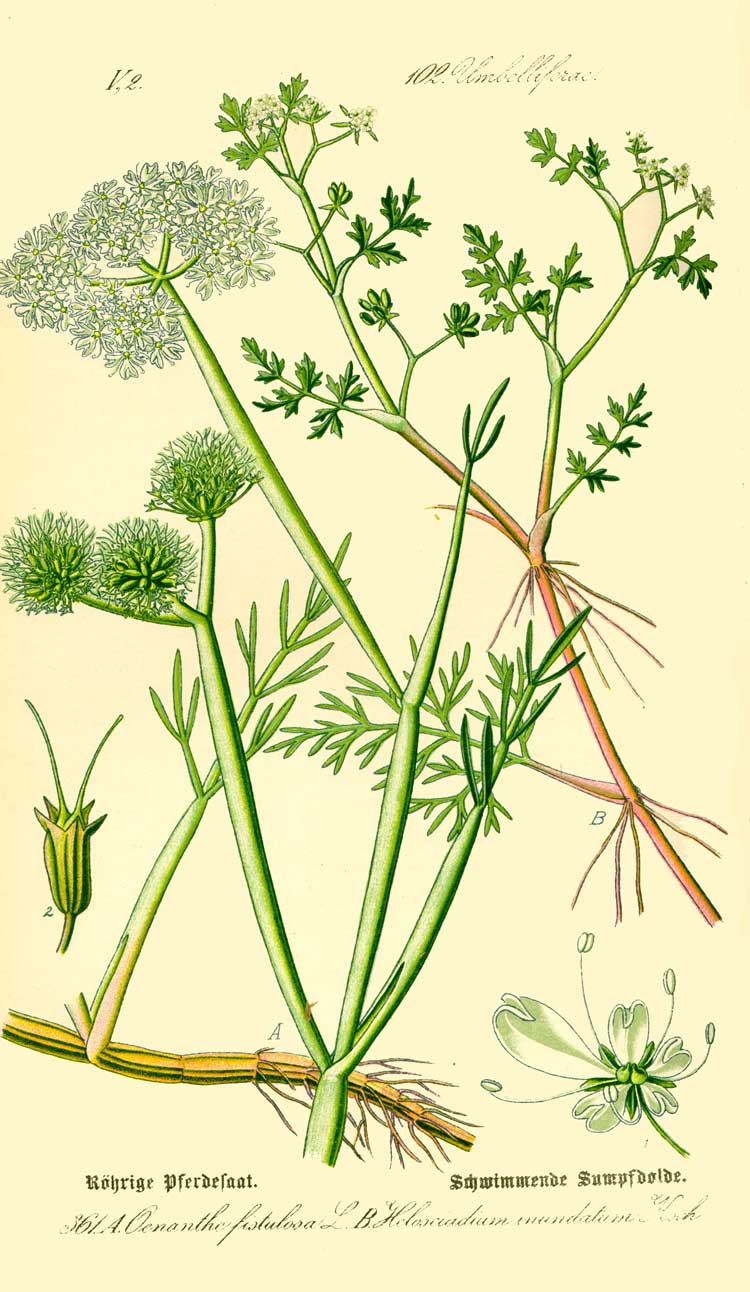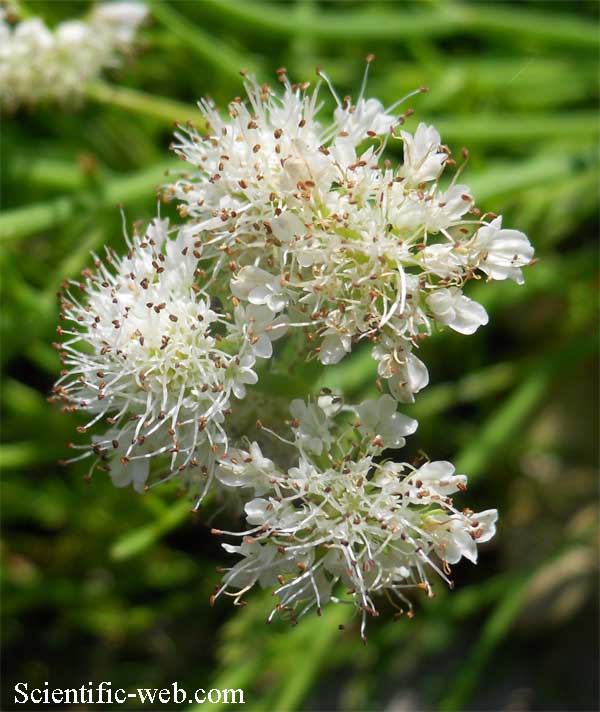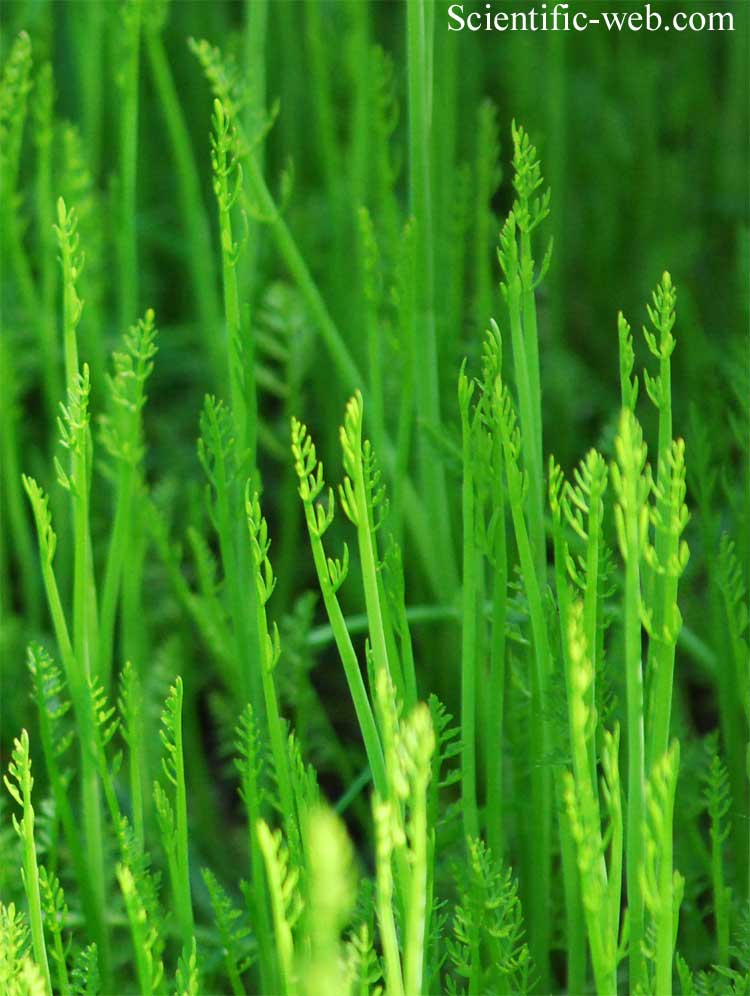
Oenanthe fistulosa (*)
Classification System: APG IV
Superregnum: Eukaryota
Regnum: Plantae
Cladus: Angiosperms
Cladus: Eudicots
Cladus: Core eudicots
Cladus: Asterids
Cladus: Campanulids
Ordo: Apiales
Familia: Apiaceae
Subfamilia: Apioideae
Tribus: Oenantheae
Genus: Oenanthe
Species: Oenanthe fistulosa
Name
Oenanthe fistulosa L., 1753
Synonyms
Oenanthe fistulifolia Stokes
Oenanthe lanceolata Poir.
Oenanthe meifolia Schloss. & Vuk.
Oenanthe tabernaemontana C. C. Gmel.
Phellandrium dodonaei Bub.
Selinum fistulosum (L.) E. H. L. Krause
Homonyms
Oenanthe fistulosa Asso = Oenanthe peucedanifolia Pollich
Distribution
Native distribution areas:
References
Linnaeus, C. 1753. Species Plantarum. Tomus I: 254. Reference page.
Links
Hassler, M. 2018. Oenanthe fistulosa. World Plants: Synonymic Checklists of the Vascular Plants of the World In: Roskovh, Y., Abucay, L., Orrell, T., Nicolson, D., Bailly, N., Kirk, P., Bourgoin, T., DeWalt, R.E., Decock, W., De Wever, A., Nieukerken, E. van, Zarucchi, J. & Penev, L., eds. 2018. Species 2000 & ITIS Catalogue of Life. Published on the internet. Accessed: 2018 Aug. 24. Reference page.
International Plant Names Index. 2018. Oenanthe fistulosa. Published online. Accessed: Aug. 24 2018.
The Plant List 2013. Oenanthe fistulosa in The Plant List Version 1.1. Published on the internet. Accessed: 2018 Aug. 24.
Tropicos.org 2018. Oenanthe fistulosa. Missouri Botanical Garden. Published on the internet. Accessed: 2018 Aug. 24.
USDA, ARS, Germplasm Resources Information Network. Oenanthe fistulosa in the Germplasm Resources Information Network (GRIN), U.S. Department of Agriculture Agricultural Research Service. Accessed: 07-Oct-06.
Vernacular names
English: Tubular Water Dropwort
suomi: Pulleapahaputki
Oenanthe fistulosa, tubular water-dropwort, is a flowering plant in the carrot family, Apiaceae, native to Europe, North Africa and western parts of Asia. It is a declining plant of wetlands.
Description
Tubular water-dropwort is a hairless, stoloniferous perennial growing up to 80 cm tall with brittle, hollow, inflated cylindrical stems 0.5 cm in diameter, which are constricted at the nodes (hence the specific name fistulosa). The upper leaves are once to twice pinnate with simple linear leaflets; the lower ones 2-3 times pinnate, with wider, flat leaflets, more like those of other umbellifers. The leaf stalks of the upper leaves are fistular, like the stem, and longer than the pinnate leaf blade.
It flowers between July and September in northern Europe, with clusters of 2-4 umbels about 1 cm in diameter, each of which has numerous white to pinkish flowers. A distinguishing feature is that, unlike many other umbellifers, it has no bracts but only small bracteoles on the individual umbels. Plants are monoecious, with hermaphroditic and male flowers on the terminal umbels, and only male flowers on the lateral umbels. Each flower has 5 unequal petals with the larger, outer ones radiating, 5 stamens and 2 prominent styles arising from a swollen base (stylopodium) at the top of the ovary. After flowering, the flower stalks and fruits expand to form distinctive pink balls with the remains of the styles projecting in pairs from the surfaces of the cone-shaped fruits.[1][2]
The chromosome number is 2n = 22 (based on British specimens).[1]
Oenanthe fistulosa fruits.jpg Oenanthe fistulosa basal leaves.jpg
Fruits (left) and lower leaf (right) of tubular water-dropwort
Distribution and habitat
The global range of tubular water-dropwort is from Europe through the northern half of Africa to western parts of Asia. It occurs no further north than southern Scandinavia and is rare as an introduction beyond its natural range. In Britain and Ireland it is found mainly in the lowland eastern counties, becoming increasingly rare towards the uplands of the north and west.[1][3] In France the pattern is similar, with the main populations in the southern lowlands, becoming rarer towards the upland regions around the Alps.[4]
Botanical drawing of tubular water-dropwort
It is a wetland plant, occurring naturally in swamps and marshes along valleys and in river deltas such as the Camargue in France[5] and the Doñana National Park in Spain.[6] In well-drained agricultural landscapes it is now more likely to be found in drainage ditches, farm ponds and grazed wet meadows. In some places it is found as a halophyte in coastal dune slacks or brackish grazing marshes, as at Aiguamolls de l'Empordà in Spain[7] or on the Sefton Coast in Britain.[8][9]
It favours clean, mesotrophic water, slightly base-rich conditions, and moderately high light levels, which make it an axiophyte in most British counties.[10] In France it is an indicator of the Gratiola officinalis-Oenanthe fistulosa community in restored wetlands along the Saône river.[11]
Its Ellenberg values in Britain are L = 7, F = 9, R = 7, N = 6, and S = 0.[12]
Uses
Unlike some other water-dropworts, O. fistulosa is not notably toxic, and it is freely grazed by livestock. It is used in traditional medicine in Algeria and investigations into the essential oil show that it could have medical benefits as well as uses in deterring mosquitoes involved in transmitting Dengue fever.[13] It has even been reported as part of the traditional cuisine in parts of southern Italy.[14]
References
Tutin, T.G. (1980). Umbellifers of the British Isles. London: Botanical Society of the British Isles.
Rose, Francis (2006). The Wild Flower Key. London: Frederick Warne.
Global Biodiversity Information Facility. "Oenanthe fistulosa L."
Inventaire National du Patrimoine Naturel. "Œnanthe fistuleuse".
Corre, J.J. "Etude phytoecologique des milieux littoraux sales en Languedoc et en Camargue II". Vie et Milieu. 28: 1–49.
García-Murillo, Pablo (2014). Las plantas de la marisma del Parque Nacional de Doñana (España) (PDF). Universidad de Sevilla.
Watt, S. "A comparative study of the vegetation at Aiguamolls de l'Emporda wetlands (N.E. Iberian peninsula)". Scientia Gerundensis. 23: 109–154.
Smith, Philip H. (2005). An inventory of vascular plants identified on the Sefton Coast (PDF).
Smith, Philip H. (2010). "Tubular Water-dropwort on the Sefton Coast sand-dunes, Merseyside" (PDF). BSBI News. 113: 13–19.
Stroh, Peter. "BSBI species accounts: Oenanthe fistulosa L." (PDF). Retrieved 31 January 2015.
Bornette, Gudrun (1999). "Biodiversity in the floodplain of Saone: A global approach". Biodiversity and Conservation. 8 (6): 839–864. doi:10.1023/A:1008807328566. S2CID 42241272.
Hill, M.O.; Mountford, J.O.; Roy, D.B.; Bunce, R.G.H. (1999). Ellenberg's indicator values for British plants. ECOFACT Volume 2. Technical Annex (PDF). Institute of Terrestrial Ecology. ISBN 1870393481. Retrieved 29 May 2017.
Souilah, Nabila (2020). "Chemical composition of essential oil of the species Oenanthe fistulosa L. growing in Algeria". Journal of Complementary Medicine Research. 11: 13–18. doi:10.5455/jcmr.2020.11.01.03. S2CID 226436163.
Savo, Valentina (2019). "When the Local Cuisine Still Incorporates Wild Food Plants: The Unknown Traditions of the Monti Picentini Regional Park (Southern Italy)". Economic Botany. 73: 28–46. doi:10.1007/s12231-018-9432-4. S2CID 59525209.
Retrieved from "http://en.wikipedia.org/"
All text is available under the terms of the GNU Free Documentation License



